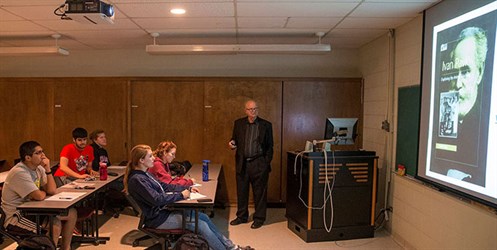Texas A&M Offers New and Unique Course
COLLEGE STATION, TX – The Texas A&M College of Veterinary Medicine & Biomedical Sciences (CVM) is offering a course this fall that is somewhat different from its typical topics of anatomy and physiology. Dr. W.R. Klemm, Professor of Neuroscience at the CVM, is teaching Neuroscience and Religion as an upper-division undergraduate BIMS elective.
“We will explore how neuroscience and religion should inform and enrich each other,” Klemm said. Although the course will be based in reading assignments from his textbook, titled “Core Ideas in Neuroscience,” those principles will be accompanied by religious and philosophic perspectives. For example, when discussing evolution of the nervous system, the students will also consider the Biblical book of Genesis and other creation stories. The lesson about action potentials-the cellular process that transmits information within and between neurons-will also include a discussion of Descartes and dualism between mind and brain.

“Many people struggle with the conflicts between evolution and religion,” Klemm said. “As a neuroscientist, I know that the human mind has a material basis, and that may cause even more cognitive dissonance for people.” In other words, if physical processes in the brain give rise to the concept we call the mind, what does that mean for free will, the concept of self, and even the soul?
“Many polls show that most scientists are atheists,” Klemm said. “I think that is unfortunate to say the least.”
One of Klemm’s goals for the course is to show students that science and theology don’t have to contradict each other. “I am hoping that the students learn to be more introspective, open minded, and mature about their spirituality,” Klemm said. “I fully expect this course will change the beliefs of everyone involved, and that includes me.”
When asked why they wanted to take the class, students cited curiosity, the opportunity to challenge themselves, and a general interest in the two subjects of science and religion. Several noted the uniqueness of the combination of topics, with one student commenting that she enrolled to get a different perspective on both. Finally, some students just went with a reason one doesn’t often hear: “I just thought it would be fun.”
The course, which is limited to 20 students to facilitate discussion and interaction, filled the same day it was announced. These students are mostly Biomedical Science (BIMS) majors, but four are majoring in something else-anthropology and psychology, for example-and pursuing the religious studies minor.
The course satisfies the university standards for a “writing (W)” certification. Klemm requires students to write, comment on, and lead class discussions of their essays and summaries of research papers in both fields that integrate neuroscience and religion. Writing can develop student abilities to organize and clarify their thinking, and Klemm critiques every essay to help students develop communication skills.
“I was so delighted when Dr. Klemm contacted me and told me he was going to offer a course in neuroscience and religion,” said Dr. Donnalee Dox, Director of the Texas A&M Religious Studies Program in the College of Liberal Arts. “The relationship between science and religion is an up and coming field, and I’m very excited about this class.”
Dox spoke to the students for a few minutes during the first class session about how to study religion in an academic setting, noting the different approaches researchers can take. Speaking to the BIMS majors in the class, she noted that the study of religion has more grey areas than they might be used to in some of their other courses, and advised trying to accept those ambiguities.
Klemm and Dox have also submitted a pre-proposal to the Templeton Foundation to enhance the course and to develop an academic discipline around the theme of “Belief Neuroscience,” with an emphasis on why humans believe things-religious and otherwise-even with incomplete evidence.


